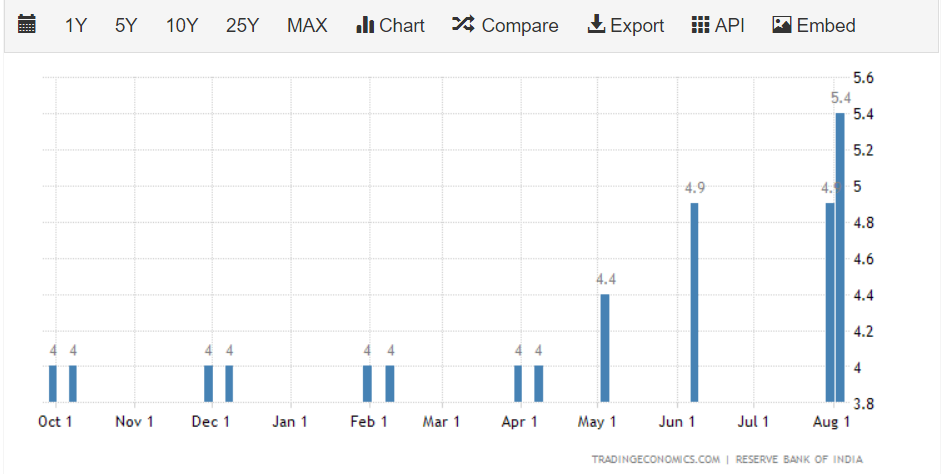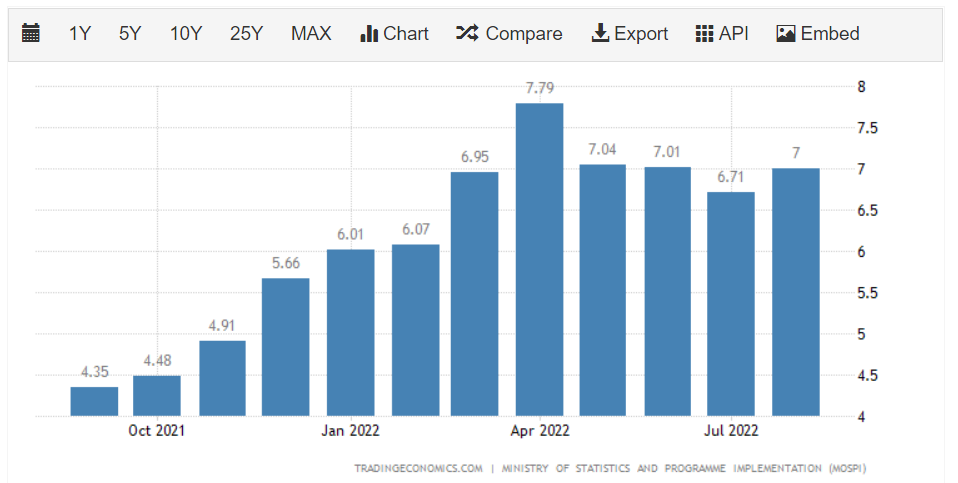A prospective client wanted us to review his investment portfolio. He is a conservative investor with only fixed-income products in his portfolio. Safety of capital is his prime concern and was happy with FD+ returns.
Actually, he was unaware of how mutual funds work and perceived that mutual funds only invest in stock markets. He was unwilling to take the equity risk so never bothered about these. He only had Bank FDs, PPF, and other small saving schemes in his investment portfolio. (Read our detailed article on Small saving schemes & interest rate volatility)
But in 2021, when the FD interest rates fell to nearly 5%, on a friend’s advice, he tried his hands on Debt Mutual funds. The past returns were looking quite attractive in comparison to the then FD rates.
It was an ‘”OK” kind of return in the initial days but when the interest rate cycle reversed in the last few months, due to the inverse relationship between bond prices and interest rates, his debt mutual fund portfolio returns slipped to nearly 4%.
Now again he was in a fix. As now he says that Bank FDs were better and he made a mistake by moving to Debt Mutual funds.
But now, he decided to ask for professional advice, before taking any action.
His simple query was that since the interest rates have started rising and FDs are providing better yields now and started looking attractive again. Should he redeem his portfolio and park money back in Bank FDs or continue with the same?
We explained that it is a temporary phenomenon due to the inverse relationship between bond prices and interest rates in the economy.
When the interest rates rise, the prices of existing bonds decrease and vice versa. Now, when the interest rate stabilizes, you will see the bond yields increase again, which will compensate for the fall in prices that happened in recent times.
That’s why, nowadays most Debt Mutual funds are showing a YTM of 6.20% – 7.20%, depending on the type of fund. (Read: Types of Debt mutual funds)
We also explained to him various other advantages of debt mutual funds and bonds over FDs, in detail.
It is a common query that many investors have in these times. Our clients also ask these questions when we review their Investment Portfolios. So, we thought of writing a detailed article on this subject that would be useful for others too.
FD interest rates are rising (again):
Let’s start with a few technical details.
Over the past few months, the Reserve Bank of India has started raising the repo rates. The most recent 50 basis point hike in the August 2022 monetary policy settled the repo rate at the current 5.40%, a total of a 1.40% hike over the last 5 months. This was the third consecutive hike in recent months. Previously, there was a 40 basis points hike in May 2022 and a 50 basis point hike in June 2022. (Read: How RBI manages inflation and growth in the economy?)
Actually, RBI is increasing the rate to control the rising inflation in the economy ranging between 6-7% in the last few months. It is way above the Government’s target of 4% with the tolerance range of +/- 2%, i.e., the upper limit is 6% and the lower limit is 2%.
In effect to this, almost all the banks have raised their FD interest rates during the last few months. The rates offered by large banks like- SBI, ICICI, HDFC, etc. on 3 to 5-year FDs range between 5.5%-6%. Small Banks and NBFCs offer a more attractive rate of 6.5%-7.75%. Senior citizens enjoy an additional interest of 0.25%-0.5% above this rate.
Also Check- 5 New tax benefits for Senior citizens in AY 2020-21 & Beyond
Inflation and tax will erode the returns:
While the FD interest rates are looking attractive right now, you should look at inflation in recent months. It has crossed the upper band of the acceptable limit, i.e. 6%, and is ranging somewhere between 6-7%.
So, FD interest below the inflation rate is theoretically negative returns in real terms. In fact, you are losing your money as the purchasing power of the same amount is reducing due to inflation. (Read: What is inflation and how it impacts your financial plan?)
Dr. Raghuram Rajan uses a concept called “Dosanomics” to support the statement that increasing interest rates in times of high inflation do not yield many benefits. The story goes like this-
A person is very fond of Dosas and for instance, the price of 1 Dosa is Rs.50. He has Rs.1 Lakh in his bank account. If he purchases dosas with this amount, he can have 2,000 dosas. But, he sacrifices his urge of having the Dosa now and invests the amount in a Bank FD thinking that he would be able to buy more dosas when the FD matures.
Now, let’s assume the FD interest rate is 5% so his Rs.1 Lakh investment becomes Rs.1.05 Lakhs at the end of the year. But, during the same tenure, if the inflation is 6% and the price of Dosa has risen to Rs.53. So, now the person can have only 1,980 dosas with the same amount, with interest.
It means rather than increasing the purchasing power, investing in FD in times of high inflation has somewhat reduced it.
The other thing is “tax”. Interest income from FD is fully taxable. So, if you earn a 6% interest on FD and fall under the 20% or 30% tax slab, your net returns post-tax would be 4.80% and 4.20% respectively. This further eats up the returns.
So, it can be said that high inflation along with high taxes can turn the final real returns from FDs negative.
Are there any alternatives available for Bank FDs?
There are various low-risk alternatives available for Bank FDs, in the fixed-income space. Some are listed below:
RBI Bonds and Government securities:
You can consider investing in the RBI floating rate bonds, or Govt. securities. The RBI bonds currently have an interest rate of 7.15% and the 5- year G-sec has a yield of around 7-7.5%. Although the interest is taxable, just like fixed deposits.
These bonds will come with a sovereign guarantee with almost negligible credit or default risk.
Read our detailed articles on-
FDs of small finance banks/NBFCs:
There are many small finance banks that are offering FD interest rates higher than the Big Banks’ FDs. But considering the Deposit Insurance Guarantee of Rs 5 lakh per deposit per bank, you may like to diversify the deposit in different banks. But do remember, over-diversification may result in management issues or complexity, so you may consider other deposits too.
FDs by NBFCs / HFCs may also be considered for high rates with the understanding that they are not covered under any guarantee by DICGC, and thus has to be looked into cautiously. (Read: How Deposit Insurance Credit Guarantee Scheme works in India?)
SCSS or PMVVY:
If you are a senior citizen, you can definitely consider Senior Citizens Savings Scheme (SCSS) or Pradhan Mantri Vyay Vandana Yojana (PMVVY), as an alternative to the 5 or 10-year FD. SCSS offers an interest rate of 8.2% p.a. (Apr 2023) and the rate of PMVVY comes to around 7.40% p.a. (Read our detailed article on Pradhan Mantri Vyay Vandana Yojana)
Debt Mutual Funds:
Various categories of debt mutual funds like Fixed Maturity Plans or target maturity funds are a much more efficient alternative to FDs. These funds invest in Government securities and high-rated PSU bonds and hold them until maturity. (Read: Target Maturity Funds: Is Passive debt Investing a Good Strategy?)
That way, not only are these considered to be safe but if you hold them until maturity, the yields become predictable as well. It is fund YTM minus the expense ratio. (Read our article on mutual fund expense ratio)
The other advantage is that indexation benefits available on the long-term capital gains on debt funds make them tax-efficient as well. If we hold these bonds for 3 years or more, the gains would be treated as long-term and the purchase price of the bonds would be inflated on the basis of the Cost Inflation Index number to calculate taxable gains. These gains are taxed at 20%. (Read our detailed article on taxation of mutual funds)
Effectively, the tax rate becomes much lower than what you pay on the FD interest, especially if you belong to the higher tax slabs.
If you go with Open-ended debt funds (like Dynamic bond funds or short-term funds), then you get liquidity and flexibility too. Though the predictability of return is less, if you stay invested for a longer term, in the end, you will find a similar kind of return as in any fixed return product.
Unlike FD where premature withdrawal attracts penalties in the form of low rates, you can withdraw your investment in debt mutual funds at market value when you need money, without any penalties.
Also Check- 6 Safe Investment options in India
Conclusion:
Although the FD interest rates started rising after a long time, it may be a temporary measure by the RBI to curb the increasing inflation due to global economic conditions.
Yes, FDs are good for parking emergency funds or funds required for very near-term requirements, especially where the safety of capital is the prime concern. But are not efficient if you have an investment duration of more than 3 years.
There are other efficient alternatives in the fixed income space that investors can take advantage of that are comparatively safer and offer better yields.









 Manikaran Singal is the founder and Chief financial planner at Good Moneying Financial Solutions. He is a CERTIFIED FINANCIAL PLANNER CM and SEBI registered Investment adviser (Regd no. INA 100001620). He’s having 20+ years of experience in financial services space.
Manikaran Singal is the founder and Chief financial planner at Good Moneying Financial Solutions. He is a CERTIFIED FINANCIAL PLANNER CM and SEBI registered Investment adviser (Regd no. INA 100001620). He’s having 20+ years of experience in financial services space.


2 Points:
1. With the recent budget amendment withdrawing indexation benefit in taxation of LTCG on debt funds and taxability at marginal rate, tax benefit is taken out of the equation.
2. Article mentions effect of inflation on FD s. Same is applicable on debt funds also and hence this point is also neutralized.
Bottomline : Debt funds are getting less attractive. There is no scope for alpha plus returns unless they compromise by investing in lower rated bonds and debt instruments.